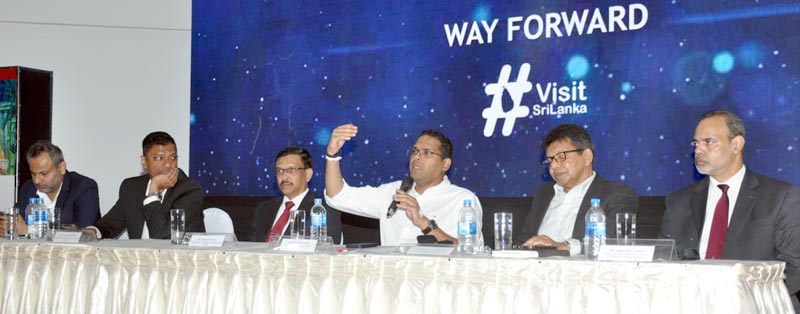Friday Dec 05, 2025
Friday Dec 05, 2025
Friday, 11 August 2023 02:24 - - {{hitsCtrl.values.hits}}

Tourism Minister Harin Fernando gestures during the media briefing yesterday. Others (from left) Sri Lanka Convention Bureau Chairman Thisum Jayasuriya, Sri Lanka Tourism Promotion Bureau Chairman Chalaka Gajabahu, Tourism and Lands Ministry Secretary Buwaneka Herath, Sri Lanka Tourism Development Authority Chairman Priantha Fernando and Sri Lanka Institute of Tourism and Hotel Management Chairman Shirantha Peiris – Pic by Lasantha Kumara
By Charumini de Silva
The country’s crucial yet struggling city hotels will get a lifeline with the return of Minimum Room Rate (MRR) regime from 1 October 2023 a move which industry officials yesterday identified as positive but comes with strict penalties if found to be violating.
The announcement by officials comes amidst divisions within the tourism industry with a MRR championed by The Hotels Association of Sri Lanka (THASL) and the Colombo City Hotels Association (CCHA) but scorned by Sri Lanka Association of Inbound Tour Operators (SLAITO) and industry leaders individually giving mixed opinion on the merits and demerits.
However, Tourism Minister Harin Fernando told a media briefing yesterday that the end goal is to attract high-end tourists.
“International hotel brands coming into Sri Lanka will give a huge edge to the tourism industry. Sailing, yacht boarding, diving are signs of high end tourism. Our end goal is to attract Indian celebrities to fly in their private jets and enjoy vaccination in their yachts,” Fernando told the briefing flanked by heads of key State tourism agencies.
He also reiterated that hotels and resorts in Yala are earning a minimum $ 600-700 for bed and breakfast basis which shows the capacity to operate within that high-end room rates if there is a unique product to be offered.
Sri Lanka Tourism Development Authority Chairman Priantha Fernando said the legislation is currently undergoing review by the legal draftsman's office and is expected to be gazetted soon.
The city hotels operated under a MRR until the 2019 Easter Sunday terror attacks.
“To ensure proper oversight, a reputable audit firm will be appointed to monitor the implementation and progress of the MRR compliance,” Fernando said.
He emphasised the subtle yet powerful message conveyed by pricing, which significantly impacts perceptions of product and service quality. “The new regulation aims to uphold quality standards and enhance the overall tourism experience in the destination,” he added.
According to Fernando, the MRR structure has been meticulously defined to accommodate different hotel categories: $ 100 for 5-star hotels, $ 75 for 4-star establishments, $ 60 for 3-star accommodations, and $ 50 for others. However, he said that special provisions will be made for rates applicable to Meetings, Incentives, Conferences, and Exhibitions (MICE) travellers, recognising the unique nature of such events.
“For those who may be tempted to disregard the MRR, the consequences could be severe. If a 5-star hotel is found in violation of these regulations may face dire repercussions, including the cancellation of its license, renewal license, and re-registration, along with a substantial penalty of Rs. 5 million,” he stressed.
The MRR system was in place from 2010 to 2019 but was discontinued following the Easter Sunday attacks. With the implementation of the MRR, Sri Lanka Tourism was successful in attracting 2.3 million tourist arrivals in 2018, making it the industry's best year so far, whilst last year's arrivals plummeted to only 700,000, matching the levels seen back in 2010.
In late 2009, a $ 125++(or around $ 185, inclusive of taxes) for five-star hotels was enforced in anticipation of increasing tourist arrivals and following complaints by small hotels of price cutting by five-star hotels. For four-star hotels, the MRR was $ 95++ and three-star $ 85++. SLCB got approval for special five-star rates of $ 100++ for MICE travellers and $ 90 ++ for four-star accommodation. The scheme was a fitting move at the time it was imposed as room rates then were as low as $ 40.
Fernando expressed optimism about the potential benefits of the MRR for all stakeholders involved in the tourism industry. He pointed to the successful example of Yala Hotels and Resorts, where over 500 rooms have enjoyed occupancy rates ranging from 85% to 90%.
“The implementation of the MRR signifies a balanced approach to welcoming high-end tourists while safeguarding the overall reputation of Sri Lanka as a premier travel destination. By maintaining high-quality offerings, the country aims to attract high-spending travellers, ultimately boosting revenue. The country strives to chart a sustainable growth trajectory for the tourism sector, setting its position as an attractive and high-quality getaway,” he added.
Noting that the industry recorded over $ 1 billion in income by the end of July, Fernando stressed the importance of a strategic approach to further increase industry revenue. “This involves not only attracting more visitors but also ensuring their satisfaction through top-notch experiences,” he added.
One of the overarching goals outlined by Fernando, is to elevate the average daily spending of tourists from the current $ 180-185 to $ 300 per day, with a long-term objective of reaching $ 500 by 2030.
Expressing confidence in the industry's potential to welcome two million arrivals this year, he was optimistic in setting sights on doubling arrivals to 5 million and earning an impressive $ 21.6 billion within seven years.